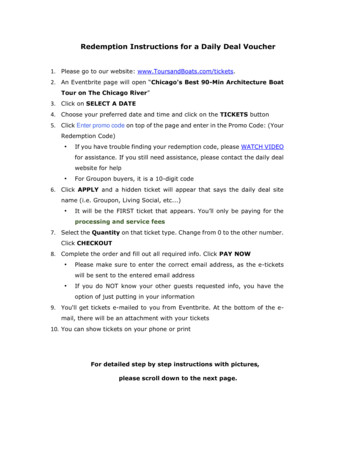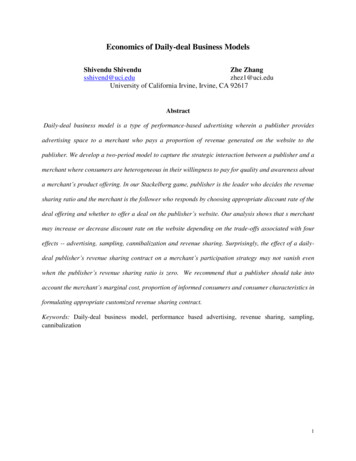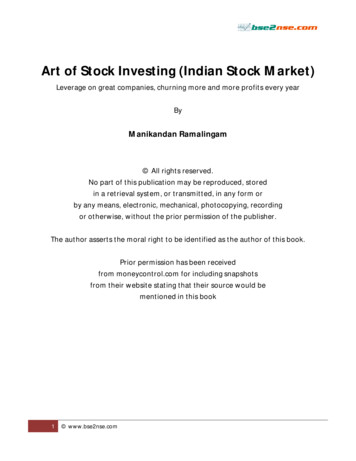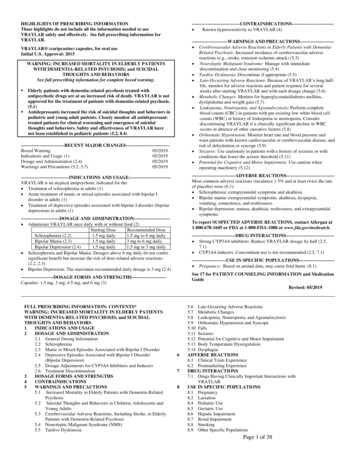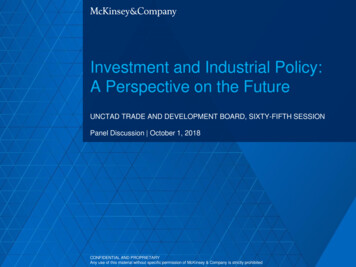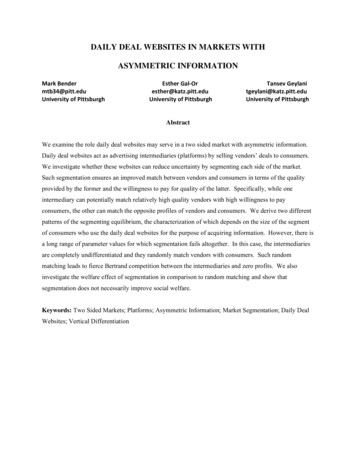
Transcription
DAILY DEAL WEBSITES IN MARKETS WITHASYMMETRIC INFORMATIONMark Bendermtb34@pitt.eduUniversity of PittsburghEsther Gal‐Oresther@katz.pitt.eduUniversity of PittsburghTansev Geylanitgeylani@katz.pitt.eduUniversity of PittsburghAbstractWe examine the role daily deal websites may serve in a two sided market with asymmetric information.Daily deal websites act as advertising intermediaries (platforms) by selling vendors’ deals to consumers.We investigate whether these websites can reduce uncertainty by segmenting each side of the market.Such segmentation ensures an improved match between vendors and consumers in terms of the qualityprovided by the former and the willingness to pay for quality of the latter. Specifically, while oneintermediary can potentially match relatively high quality vendors with high willingness to payconsumers, the other can match the opposite profiles of vendors and consumers. We derive two differentpatterns of the segmenting equilibrium, the characterization of which depends on the size of the segmentof consumers who use the daily deal websites for the purpose of acquiring information. However, there isa long range of parameter values for which segmentation fails altogether. In this case, the intermediariesare completely undifferentiated and they randomly match vendors with consumers. Such randommatching leads to fierce Bertrand competition between the intermediaries and zero profits. We alsoinvestigate the welfare effect of segmentation in comparison to random matching and show thatsegmentation does not necessarily improve social welfare.Keywords: Two Sided Markets; Platforms; Asymmetric Information; Market Segmentation; Daily DealWebsites; Vertical Differentiation
1. INTRODUCTIONDaily deal websites, such as Groupon, LivingSocial, Google Offers, Amazon Local, and Double TakeDeals, are websites that sell deals on services or products. Consumers who visit these websites andpurchase such deals are given gift certificates or gift vouchers to later redeem with a specific vendor whohas entered into an agreement with the daily deal website. Daily deal websites are platforms seeking toattract both vendors and consumers in a two-sided market. Consumers visit these platforms because theyprovide a vehicle to learn more about a specific product or service without having to pay full price for it.Vendors sell deals through these platforms because the platforms have a vast reach due to large consumersubscription bases. Often times these vendors are local and/or independent mom and pop shops whoutilize daily deal websites in order to attract consumers to their business at a reduced price. Their hope isthat upon having a good experience with the service, these consumers will return in the future to purchasethe service again at full price.As is the case with most platforms looking to lure many consumers on one side of the market inan effort to create network benefits for producers on the other side of the market, daily deal websites offertheir services to consumers with no usage or subscription fees in order to build a consumer base. Havingbuilt consumer bases to which vendors want access, daily deal websites are able to keep a fraction of therevenue made from each deal sold on their website. It has been noted that the fraction of revenue thatdaily deal websites keep for themselves can reach upwards of 50%.1 These platforms operate at thenational level and consider themselves as advertising intermediaries that help expose unknown vendors toconsumers.However, selling through daily deal websites also introduces risks to the vendors. One such riskis the fact that deals may attract consumers who have no intention of making a repeat purchase at fullprice. A second risk is related to the heterogeneity in the vendor and consumer populations. Withvendors offering products of different quality and consumers having different willingness to pay forhigher quality, a mismatch between vendors and consumers types may limit the ability of vendors toextract surplus from consumers. In this paper we explore the possibility that daily deal websites mayreduce the second type of risk by segmenting both the vendor and consumer markets. At such asegmenting equilibrium the platforms can increase the likelihood of correct matches between vendors andconsumers.In our model there are two daily deal websites (platforms). The vendor population isdifferentiated by quality and the consumer population is differentiated by willingness to pay for higherquality. Consumers cannot distinguish between high and low quality vendors, and similarly, vendorscannot distinguish between high and low willingness to pay consumers. We explore the possible existence1See roupon-hysteria/1
of a segmenting equilibrium whereby each platform specializes in matching different segments of vendorsand consumers. Specifically, while one platform matches high quality vendors with high willingness topay consumers (high quality “matchmaker”), the competing platform matches the opposite profiles ofvendors and consumers (low quality “matchmaker”.) This possible matching of different segments of thepopulations results in vertically differentiated platforms. However, in contrast to traditional models ofvertical product differentiation, at a segmenting equilibrium platforms are differentiated not because theyactively choose to offer different qualities of service. Rather, when different segments of the vendorpopulation self-select to be represented by different platforms, part of consumers’ uncertainty regardingquality is alleviated, and quality differentiation between platforms endogenously arises. Put differently, itis the selection of platforms by the different segments of the vendor and consumer populations and not theactive choice of quality by the platforms themselves that generates the vertical differentiation between theplatforms.We find that market conditions characterizing the rewards for high quality that vendors receivedetermine whether or not segmentation of the vendor and consumer populations can be supported. Whenthe reward high quality vendors expect from repeat purchases by consumers is significant, the highquality platform offers a more generous deal to consumers than the low quality platform, and when thisreward is low, it is the low quality platform that offers the more generous deal. However, unless there areeither significantly high or low rewards to quality, a segmenting equilibrium fails to exist. In the absenceof segmentation, platforms are not differentiated and random matching of vendors and consumers arises.Random matching leads, however, to fierce (undifferentiated Bertrand) competition between platforms,and therefore, to zero profits. We find that such random matching may arise, indeed, for a large range ofvalues of the parameters of the model. The possible non-existence of a segmenting equilibrium and theundifferentiated competition between the platforms, can explain, to some extent, the recent poorperformance of the daily deal websites.2The difficulty in obtaining a segmenting equilibrium by using the deal price as the onlyinstrument can explain why platforms may have to resort to additional instruments in order to facilitatedifferentiation. Groupon, for instance, sometimes requires a certain number of customers for a deal to gothrough. LivingSocial has no such tipping point rule.3 LivingSocial is also known to pay back merchantsquicker than Groupon.4 The recent attempt by some daily deal websites such as FabFind.ca and Vipdealsto establish themselves as leaders in niche markets that match luxury merchants with consumers who2For instance, Groupon and Living Social, the two largest daily deal websites, lost 256.7 million and 558 million,respectively in 2011. In addition, in just the last half of 2011, 798 deal sites (including consolidations) pon-and-livingsocial-do-more-harm-good)3See ng-social4See oupon-and-Living-Social2
have a penchant for luxury5 is also consistent with our prediction that platforms have incentives to servedifferent segments of the populations of merchants and consumers in order to avoid undifferentiated pricecompetition.Our study contributes to four streams of research. The first is the literature on platformcompetition in two-sided markets. Much of this literature has investigated competition betweenhorizontally differentiated platforms (Gabszewics et al. 2002, Armstrong 2006, Hagiu 2009, Gal-Or et al.2012). One exception is a study by Brown and Morgan (2009) who investigate whether two platformscan coexist in equilibrium when one offers superior service than the other. In our paper, however, verticaldifferentiation between the platforms arises through self-selection by heterogeneous populations ofconsumers and vendors. The quality of the platform is not under its control. Rather, it is the segments ofthe consumer and vendor populations who choose to transact with the platform that determine its quality.Similar to our study, in Hagiu and Spulber (2012) and Caillaud and Juilen (2003) as wellplatforms differ because of users’ expectations about how the other side of the market behaves. In ourmodel the consumer and vendor populations are heterogeneous. While one intermediary matchesrelatively high quality vendors with high willingness to pay consumers, the other matches the oppositeprofiles of vendors and consumers. In contrast, in Hagiu and Spulber (2012) and Caillaud and Juilen(2003) the populations on both sides of the market are homogenous. Platforms differ because thesehomogenous users expect one platform to provide higher user participation on the opposite side of themarket than the other platform.Our study also contributes to the literature on market segmentation that is implied by qualitydifferentiation (Mussa and Rosen 1978, Katz 1984, Moorthy 1984, Schmid-Mohr and Villas-Boas 2008).In this literature firms have full control over the qualities of the products they offer and consumers selfselect among the vertically differentiated products offered by these firms. In order to supportsegmentation the firms need to satisfy only one incentive compatibility constraint related to self-selectionby consumers. However, for platforms that seek to match vendors with consumers, there is an additionalincentive compatibility constraint related to self-selection by vendors. We show that the additional vendorincentive compatibility constraint makes it harder for these platforms to implement an equilibrium inwhich both sides of the market are segmented.In our paper, daily deal websites act as a means for vendors to offer introductory prices toconsumers in order to entice trial (Bagwell 1987). If segmentation exists, these introductory prices candiffer across platforms and provide information about the quality of the vendors offering their productsthrough the respective platforms. Methods for inducing trials have also been discussed in the couponing5See eals.ae/site/how it work3
literature (Ward and Davis 1978, Levedahl 1983). However, much of the literature on couponing focuseson the price discrimination benefits that coupons can support (Narasimhan 1984, Shaffer and Zhang 1995,Lu and Moorthy 2007). In our study, the focus is on the informational role of the daily deals.Specifically, mom and pop shops use daily deals to induce trials and inform consumers about the qualityof their products through their platform choices.So far only a limited number of studies have investigated daily deal websites. Some of these areempirical (Byers et al. 2011 and Dhloika 2011). Two analytical studies that have examined daily dealwebsites are Edelman et al. (2011) and Kumar and Rajan (2012). However, both are from the perspectiveof vendors. Unlike our paper, these studies have no strategic intermediary or intermediary competition.The goal of this paper is two-fold. First, we seek to characterize conditions under whichplatforms can segment the market, and second, we investigate how such segmentation impacts the welfareof vendors, consumers, and platforms.The rest of the paper is organized as follows. In the next section we develop the model andconduct the analysis. In Section 3 we simplify the model in order to obtain a sharper description of ourresults. Section 4 concludes the paper and offers suggestions for extending our model. The Appendixcontains the proofs of all the propositions.2. MODELWe model an environment where mom and pop stores use daily deal websites to promote their services.6The objective of the websites is to encourage consumers to purchase the services at reduced prices inorder to acquire information about the vendors. Vendors hope that based upon their early experience,consumers will return to purchase their services at full price. Hence, vendors use the daily deal websitesas platforms to increase consumer awareness of their service offerings. We model, therefore, a two sidedmarket in which platforms act as intermediaries in an attempt to attract and match consumers andvendors.Even for a specific geographic region, there is often a multitude of vendors who offer a certainservice for sale (e.g. roofing, Italian dinner, massage, etc.). Given their large number, it is many times thecase that consumers are not aware of all vendors and have difficulty in distinguishing among them interms of the quality of service they provide. We model this environment by assuming that there exists acontinuum of vendors within a specific service category that are uniformly distributed based upon qualityalong the interval,. Vendorsells a service of quality ; however, the quality of each vendor is6For expositional convenience, we will limit the firm side of the market to service providers, which we will refer toas vendors throughout this paper.4
private information available only to the vendor himself.7 Because there is a continuum of vendors, eachvendor is a price-taker and no single vendor has the power to set a price. This assumption is realistic inthat mom and pop stores that utilize daily deal websites have little market power and find themselves incompetition amongst many other vendors selling a similar service. Therefore, we assume that the fullmarket price of service of qualityis exogenously determined by the function, whereisincreasing in ; namely if the quality of the vendor is known, the higher his quality the higher the price hecan charge. The price schedulemay be determined, for instance, as unit cost plus a certain profitmargin that is commonly acceptable in the vendor’s industry. As the unit cost of higher quality service isnormally higher, the scheduleis an increasing function of. There are, however, many vendors ofvery similar quality to that offered by the vendor of quality , implying that each vendor is too small tohave the market power to set prices.There are two daily deal websites that act as intermediary platforms between the consumers andvendors; these platforms compete for both the vendors’ and the consumers’ business. Each platform sellsdeals to the consumers at price8own deal pricefor ,. We assume that each platform has full control over itsand that it is as uninformed about vendor quality as consumers, implying that the samedeal price is offered for all the platform’s vendors.9 Our rationale for assuming that platforms havecomplete price setting power is justified for several reasons. First, platforms operate on a national level,but the vendors with whom they contract are often specific to a geographic area. Second, these platformshave large consumer subscription bases that can only be reached using the platform. Finally, daily dealwebsites such as Groupon feature a single deal of the day in a specific product category; hence,businesses compete for these select features and Groupon has the final power in selecting the deal thatthey wish to offer.10 We assume that each platform randomly selects only one vendor for which itfeatures a deal.11 For its services, each platform takes a share of the revenue; this share is denoted by7That is, all vendors sell the same service with the exception of a distinction in quality.Deals are usually offered in the form of discounts or gift certificates. Our formulation of setting the actual price ofthe deal can be interpreted as offering a gift certificate that guarantees the final discounted price of the service.9If platforms had more information about the quality of the vendors, they could potentially offer different dealprices to different vendors. We later conjecture about the consequences of relaxing the assumption of platforms’lack of information.10It is possible that deal-of-the-day websites will also contract with larger companies in an effort to advertise theirown services and grow their user base. However, we seek to model the more common case of these daily dealwebsites featuring deals from mom and pop shops.11It is possible that vendors can submit bids for the right to sell through the intermediaries. However, we assumethat the increased costs associated with running auctions outweigh the benefits. Indeed, we do not observe vendorbidding in major daily deal websites such as Groupon and LivingSocial.85
and we will assume it to be the same for each vendor and platform.12 For simplicity, we assume thatneither the vendor nor the platform incurs any cost.There is a continuum of consumers who are uniformly distributed based upon their willingness,to-pay for quality along the interval0. The parameter, whereof the consumer determinesher willingness to pay for quality. Specifically, the gross utility gain that a consumer of typefrom the service provided by vendorfrom the vendor at the full priceisderives. Her net gain depends on whether she buys directlyor from the platform at the reduced pricesor. Specifically,in equations (1) and (2) we express the consumer’s net payoff when buying a deal via platform ordirectly from the vendor, respectively:,(1).The parameter(2)measures the basic willingness to pay for the service that is unrelated to its quality. Weassume it to be big enough to ensure that the net payoff of the consumer is positive even when paying fullprice for the service and irrespective of the quality provided by the vendor. For instance, if the service isa meal at a restaurant, even meals of low quality can curb hunger and provide some net utility fromconsumption. Consumers can purchase at most one deal for a given service from either one of theplatforms.In addition to the heterogeneity of the consumers in terms of their willingness to pay for higherquality, consumers differ also in terms of their interest in acquiring information about vendors for thepurpose of guiding their future purchasing decisions. In this regard, we assume two different segments.The first segment consists of consumers who seek to learn about the service offered by a given vendor inorder to determine whether they will continue to buy the service from him in the future. In contrast to theinformation seeking segment, the second segment consists of one-time shoppers who buy the service onlyonce by using the daily deal websites with no intention of ever buying the service again for full price. Weassume that a fractionof all consumers consists of information seekers and a fraction 1consistsof one-time shoppers.13 If information seeking consumers have a positive experience with the service,they may return to buy the service from the same vendor at full price. We assume that the probability ofreturnis an increasing function of . Hence, an information seeking consumer of typethe following expected utility when obtaining a deal from platform , denoted by12receives:For simplicity, we consider to be an exogenous parameter that is common to both platforms. In reality,platforms may differ somewhat in their sharing rules. It may be interesting to extend our analysis, therefore, so thatthe sharing rule chosen by each platform is a decision variable. We later conjecture on how such an extension islikely to affect our results.13We may think of these one-time shoppers as individuals who purchase a deal while on a trip or have no need toever make a future purchase from a given product category. In addition, may vary across product categories. Forinstance, a deal for a concert may be less likely to attract information-seekers than a deal for a restaurant.6
consumervisits platform consumervisits platform .(3)Note that with segmentation of the vendor population consumers can improve their estimate of theaverage quality offered via each platform. The conditional expected quality terms in (3) capture theupdating of the information that is facilitated at a segmenting equilibrium. While the first term of (3)measures the expected net benefit of the consumer from the initial purchase via the platform, the secondterm measures the expected net benefit when she returns to buy the product directly from the vendor.One-time shoppers visit daily deal websites with a sole interest of obtaining a service at a reduceddeal price. These consumers have no intention of making a repeat purchase at full price; therefore, theprobability that one-time shoppers return is0 for all . A one-time shopper of type:the following expected utility when visiting platform , denoted consumervisits platformreceives.(4)Because of our focus on small mom and pop vendors we assume that before consumers choosethe platform they are barely aware of the vendor’s existence, and therefore, do not have access to anyinformation regarding the vendor’s full price or quality. This is the reason that in (3) and (4) the consumerhas to calculate the expected price and quality she is likely to encounter by choosing a given platform. Inaddition, Groupon’s or Living Social’s deals include very vague information about the full prices chargedby featured vendors. An ad may state, for instance, that the full value of an Italian meal offered is 30.Such a statement does not specify the full prices of different items on the menu, and as a result, it is oflimited informational value to consumers in learning about the specific full price of the items she likes. Inour modeling approach, we implicitly assume, therefore, that consumers cannot infer informationregarding quality from the deal’s advertised full value (by inverting the function.) With such aformulation we avoid the added complication that the daily deal website may potentially state the fullvalue of the deal in order to signal the underlying quality of the vendor.The timing of the game is as follows. First, each platform simultaneously sets a deal price,Second, given the knowledge ofplatform, each vendor decides whether to sell their “trial” service throughor platform . Simultaneously, consumers choose whether to buy a deal from platformorplatform . After trying the service and learning of the service’s quality, the information-seekingconsumers may or may not return to the vendor and make a subsequent purchase from the vendor at fullprice.2.1 AnalysisWe seek to characterize an equilibrium in which high -type vendors and high -type consumers selfselect to transact with platformand low -type vendors and low -type consumers self-select to7
transact with platform . We will refer to such an equilibrium that segments the markets as a segmentingequilibrium. Figure 1 depicts a segmenting equilibrium as defined above.14 At the segmenting equilibrium vendors of type and consumers of type and consumers of typechoose platformand vendors of typechoose platform .[INSERT FIGURE 1 HERE]As can be seen in Figure 1, we seek equilibria where two segments exist on each side of themarket and platforms are exclusively assigned to one segment on each side. If we were to assume thatplatforms have information about either side of the market (i.e., if the platforms were to track consumerbehavior or learn about vendors through repeated interactions) platforms could further segment theirpopulations of consumers and vendors by offering distinct deal prices to different groups.In order to simplify the analysis we use specific functional forms for the full price,return probability schedules,parameters, as follows:, where ,and, and the0. Hence, theand determine the steepness of these schedules. The linear specification of the functionsimplies that the price and probability schedules increase at constant rates as quality increases. If weassumed a nonlinear specification so that the rate of increase of the functions was diminishing(increasing), instead, the reward to higher quality would be more moderate (more significant,and as measures of therespectively) than in our model. In conducting the analysis, we use the slopesreward to high quality. With a nonlinear specification, additional variables related to the rate of change inthese slopes would also have to be considered.We start by analyzing the choice of the consumers between the two platforms. At a segmentingequilibrium, consumers know that platformand platform offers deals for vendors of relatively high quality ( offers deals for vendors of relatively low quality ()). They use this information toupdate their expected net utility when buying from each platform. For the information seeking consumersthe expected net utilities are: ,.(5)(6)As pointed out earlier, information seekers use the platforms to obtain information about vendors.Because of the segmentation of the vendor population they know that platform H represents, on average,higher quality vendors and platform L represents lower quality vendors. They use this information incalculating the average quality of vendors serviced by each platform.14The designation of the platforms is made without any loss of generality. We could also solve for the oppositearrangement in which high -type vendors and high -type consumers interact with platform and low -typevendors and low -type consumers interact with platform .8
From (5) and (6) we can calculate the utility gain that an individual of typevisiting platform receives fromas opposed to visiting platform : . (7)From (7), it is clear that the utility gain of buying fromrather thanis increasing in . Hence, segmentation of the information seeking consumers might be possible if there exists a,support such that 0. For types 0 and for -type inside the0, implyingthat the information seeking consumers self-select the platforms as predicted at a segmenting equilibrium.0 forSolving the equation in (7) yields: . (8)One-time shoppers have no intention of a repeat purchase. Therefore, they seek to maximize their netexpected utility when buying the service only once via one of the platforms as follows: ,(9).(10)Constructing the difference in the net utility from visiting platformas opposed to platform , weobtain: .(11)Segmentation of the one-time shoppers is feasible if there existsfunction is increasing in , consumers of typewill choose such that will choose platform0. Because theand those of type0 yields:. Solving the equation .(12)Comparing the expressions derived fordepends on the values of the parametersand , and in (8) and (12) we notice that whereasdoes not. The parametersto the consequences of repeat purchase by consumers. The parameter and are both relatedmeasures the steepness of the fullprice schedule and the parameter is related to the probability of repeat purchase by the consumer.Because one-time shoppers do not intend to ever buy the service again for full price, the values of theseparameters do not affect their behavior. The values of both and increase when the gapincreases, as more consumers opt to purchase the relatively cheaper deal from . Note also that the valueof increases whenon the values of increases and. Whendeclines. Changes in the parameter have an ambiguous effectis relatively big in comparison to , purchasing high quality service ismuch more expensive than low quality service when the consumer returns to the same vendor and pays9
full price for the service. Factoring this higher price differential implies that more consumers will chooseto experiment with the deal offered by the low quality platform andFor simplicity, define namely1is the fraction of information-seeking buyers who visit platformas the fraction of one-time shoppers who visit platform , namelyis the fraction of one-time shoppers who visit platformand 1vendors that sell a trial through platformplatform , thusthrough platformincreases.as the fraction of information-seeking consumers who visit platform ,. Therefore, 1Similarly, define , where . Finally, define . Hence,as the fraction ofas the fraction of vendors that sell a trial throughis the quality of the vendor who is indifferent between selling dealsand selling deals through platform.With knowledge of consumer strategies, vendors seek to maximize their own profits by choosingwhether to sell a product through platformprofit ofandor platform . A vendor of qualityby selling through platformreceives the expectedand platform , respectively, expressed by15the following equations.111111,(13).(14)The first term in both (13) and (14) is profits from information seekers and the second term isprofits from one-time shoppers. While the profits from information seekers accrue both from thevendor’s share of the deal1and the expected revenues from repeat purchases, theprofits from one-time shoppers accrue only from the vendor’s share of the deal. Note also that theexpected volume of customers that are likely to patronize a certain vendor via a given platform dependson the density of consumers per vendor at this platform. In the population of information seekers, thisdensity isfor the high
Daily deal websites, such as Groupon, LivingSocial, Google Offers, Amazon Local, and Double Take Deals, are websites that sell deals on services or products. Consumers who visit these websites and purchase such deals are given gift certificates or gift vouchers to later redeem with a specific vendor who



